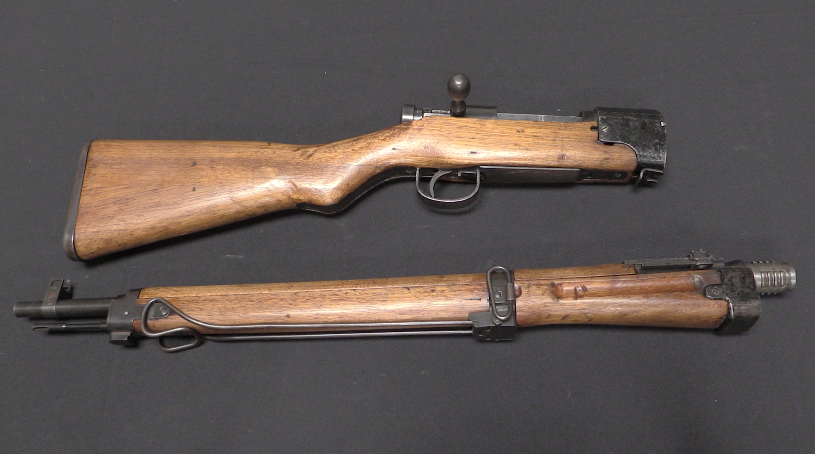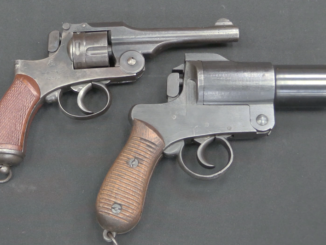In the aftermath of World War One, the Japanese military saw the utility of infantry-portable light grenade launchers instead of rifle grenades, and adopted the Type 10 grenade projector in 1921 (Taisho 10). It went into production in 1923 at the Tokyo Army Arsenal, although the great Tokyo earthquake led to production being moved to Nagoya, where about 11,000 were made between 1925 and 1937. The Type 10 was a remarkably light and handy weapon, weighing just 5.5lb (2.5kg) and disassembling into a transport configuration the size of a wine bottle.
The larger Type 89 grenade launcher was adopted in 1929, which led to the older Type 10s being relegated to use for illumination and signaling, which they did through the end of World War Two.




It appears that the Japanese jumped ahead in one way: rather than every rifle a grenade launcher, every squad has a miniature mortar that can fire its own rounds or even hand grenades if needed! I’m pretty sure the Japanese grenade launchers got quite annoying for the Marines and the US Army in the Pacific (and before that the “knee mortars” dropped explosives on the Chinese).
“relegated to use for illumination and signaling”
Similar fate has British Two-inch mortar: https://en.wikipedia.org/wiki/Two-inch_mortar
Post war, the two-inch mortar was kept in service to fire smoke and illuminating rounds.
“weighing just 5.5lb (2.5kg)”
Soviet Union during Talvisota deployed mortar which weights only 1.5 kg and is integrated into… shovel, namely 37-мм миномет-лопата образца 1939 года (37-mm mortar-shovel pattern of 1939 year), interestingly this idea was resurrected recently and in modern iteration fire ВОГ-25 grenada (ammunition for GP-25 under-barrel grenade launcher) named «Вариант», see photos here:
http://weaponland.ru/load/granatomet_lopata_variant/61-1-0-240
1st, 2nd, 3rd and 4th photo from top – 37-мм миномет-лопата образца 1939 года
5th, 6th, 7th, 8th and 9th photo from top – «Вариант»
there is a company in the US that is selling reproductions.
http://www.e-sarcoinc.com/37mm-russian-spade-mortar.aspx
The vent system of controlling breech pressure and thus range was also used on the Italian 45mm Brixia Model 35 light mortar;
http://www.lonesentry.com/articles/ttt07/italian-45mm-mortar.html
It used a set of ports under the breech that could be opened and closed singly or in pairs, etc., to regulate range.
While it fired bombs of about the same weight as the Type 10 and was smoothbored, it was a breechloader and was fairly complex by mortar standards. Like the Type 10, it was trigger-fired.
This is the first time I’ve seen any details of the Type 10, and I must say it’s an impressive little piece of equipment. With its light weight and compactness, I could see it being issued with a rubberized square canvas pouch about 10 x 8 x 2 inches, holding it in an internal sleeve, plus half-a-dozen grenades or flares, a cleaning kit and an instruction manual.
As a flare launcher, I’d call it an entirely reasonable item to include in an emergency kit on a boat or in an aircraft, even today. It could fire flares that went higher and burned longer than most hand-held “flare pistols” can.
Thank you for showing it to us, Ian.
cheers
eon
How do you deal with recoil when launching flares? Or do flares have very little recoil?
Flares tend to be lightweight, so Newton’s Third Law results in less recoil. As for dealing with it, place the spade firmly on the ground or against something; on a boat, put it on the taffrail.
In fact, if the rail is about 3 to 4 inches (7.5-10cm) diameter, you could drill a blind hole just a bit bigger that the stub of the spade attachment detent, and when needed, seat the stub right in it, and the spade on top of the rail, which would automatically point it straight up. Which is the way you generally fire flares.
To mount it there for a while, use a couple of hose clamps around the rail and the spade;
https://www.fillernecksupply.com/main-hose-clamp-select-size-from-menu/
I’ve yet to see a boat, from bass boat to cabin cruiser, that didn’t have hose clamps in the tool box.
cheers
eon
“Brixia Model 35”
I recently found article: http://www.tanks-encyclopedia.com/ww2/Italy/ansaldo-miasmoras-1935
saying that this weapon initially has to belong to “hand crank” category (see drawing from patent), which would explain why it is so complicated, nonetheless less than shown in patent drawing.
“system of controlling breech pressure and thus range was also used on the Italian 45mm Brixia Model 35 light mortar”
And also Polish granatnik wz. 36
https://en.wikipedia.org/wiki/Granatnik_wz._36
And also 5-cm Festungs-Granatwerfer 210 (f)
https://forum.axishistory.com/viewtopic.php?p=365559#p365559
as it name imply it is armament of fortifications
“light weight and compactness”
Generally, Japanese in their mortars, howitzer and cannons preferred light weight (high portability) than high range or more generally high ballistic performances, it might be explained by fact of low number of motor vehicles in Japanese forces in 1930s or environment where combat took place (often dense jungle, so some place accessible only by foot-slogging)
It’s a very handy, clever little weapon. In a “low-intensity” warfare situation, light infantry only (no tanks and AFV’s) I can see its usefulness. However, as everything made for light duty eventually gets used for heavy duty, I can see what the Japanese upgraded to the Type 89. Which is also handy and useful, though not so little.